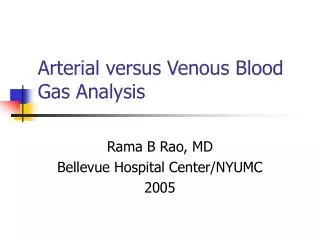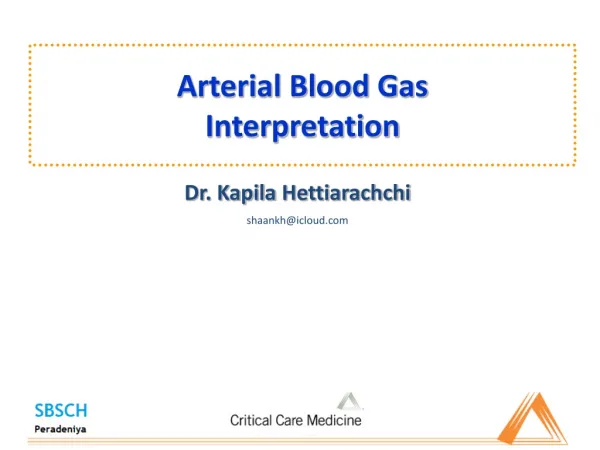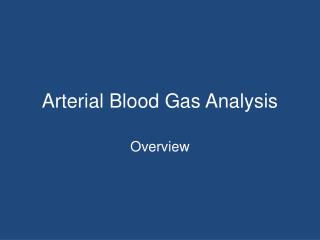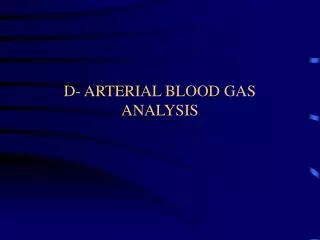Arterial Blood Gas Analysis
Arterial Blood Gas Analysis. ABG. Blood gas analysis, also called arterial blood gas (ABG) analysis, is a test which measures the amount of oxygen (O2) and carbon dioxide ( CO2) in the blood, as well as the acidity (pH) of the blood. Purpose
Share Presentation
Embed Code
Link
Download Presentation
- scoring systems
- enough oxygen
- slightly basic
- bicarbonate concentration
- acid base status
- testing

alva + Follow
Download Presentation
Arterial Blood Gas Analysis
An Image/Link below is provided (as is) to download presentation Download Policy: Content on the Website is provided to you AS IS for your information and personal use and may not be sold / licensed / shared on other websites without getting consent from its author. Content is provided to you AS IS for your information and personal use only. Download presentation by click this link. While downloading, if for some reason you are not able to download a presentation, the publisher may have deleted the file from their server. During download, if you can't get a presentation, the file might be deleted by the publisher.
Presentation Transcript
- Arterial Blood Gas Analysis
- ABG • Blood gas analysis, also called arterial blood gas (ABG) analysis, is a test which measures the amount of oxygen (O2) and carbon dioxide ( CO2) in the blood, as well asthe acidity (pH) of the blood.
- Purpose • An ABG analysis evaluates how effectively the lungs are delivering oxygen to the blood and how efficiently they are eliminating carbon dioxide from it. • The test also indicates how well the lungs and kidneys are interacting to maintain normal blood pH (acid-base balance).
- Blood gas studies are usually done to assess respiratory disease and other conditions that may affect the lungs, and to manage patients receiving oxygen therapy (respiratory therapy). • In addition, the acid-base component of the test provides information on kidney function too.
- An ABG is typically requested to determine the pH of the blood and the partial pressures of carbon dioxide (PaCO2) and oxygen (PaO2) within it. • It is used to assess the effectiveness of gaseous exchange and ventilation, be it spontaneous or mechanical. • If the pH becomes deranged, normal cell metabolism is affected.
- The ABG allows patients' metabolic status to be assessed too, giving an indication of how they are coping with their illness. • It would therefore seem logical to request an ABG on any patient who is or has the potential to become critically ill. • This includes patients in critical care areas and those on wards who 'trigger' early-warning scoring systems.
- Information provided by an ABG PaCO2 • This is the partial pressure of carbon dioxide dissolved within the arterial blood. It is used to assess the effectiveness of ventilation. A high PaCO2 (respiratory acidosis) indicates underventilation, a low PaCO2 (respiratory alkalosis) indicates hyper- or overventilation. • The normal range for a healthy person is 4.7-6.0 kPa or 35-45 mmHg although in chronic pulmonary diseases it may be considerably higher and still normal for that patient.
- PaO2 • This is the partial pressure of oxygen dissolved within the arterial blood and will determine oxygen binding to haemoglobin (SaO2). It is of vital importance but is not used in determining patients' acid base status and normally low readings indicate hypoxaemia.The normal range -9.3-13.3 kPa or 80-100 mmHg.
- SaO2 • Oxygen saturation measures how much of the haemoglobin (Hb) in the red blood cells is carrying oxygen (O2). Although similar to SpO2 (measured by a pulse oximeter), it is more accurate. The normal levels are 97% and above, although levels above 90% are often acceptable in critically ill patients.
- pH • The pH measures hydrogen ions (H+) in blood. The pH of blood usually between 7.35 to 7.45. A pH of less than 7.0 is called acid and a pH greater than 7.0 is called basic (alkaline). So blood is slightly basic.
- HCO3 (Bicarbonate) • Bicarbonate is a chemical (buffer) that keeps the pH of blood from becoming too acidic or too basic & indicates whether a metabolic problem is present (such as ketoacidosis). A low HCO3- indicates metabolic acidosis, a high HCO3- indicates metabolic alkalosis. HCO3- levels can also become abnormal when the kidneys are working to compensate for a respiratory issue so as to normalize the blood pH. Normal range - 22–26 mmol/l
- Base Excess (BE) • The base excess is used for the assessment of the metabolic component of acid-base disorders, and indicates whether the patient has metabolic acidosis or metabolic alkalosis.
- A negative base excess indicates that the patient has metabolic acidosis (primary or secondary to respiratory alkalosis). • A positive base excess indicates that the patient has metabolic alkalosis (primary or secondary to respiratory acidosis). • Normal range - -3 to +3 mmol/l
- Normal results • partial pressure of oxygen (PaO2): 80-100 mm Hg • partial pressure of carbon dioxide (PaCO2): 35-45 mm Hg • oxygen content (O2CT): 15-23% • oxygen saturation (SaO2): 94-100% • bicarbonate (HCO3): 22-26 mEq/L • pH: 7.35-7.45
- When ABG is ordered? • Blood gas tests are ordered when you have symptoms of an O2/CO2 or pH imbalance, such as difficulty breathing or shortness of breath & also if you are known to have a respiratory, metabolic, or kidney disease and those are experiencing respiratory distress to evaluate oxygenation and acid/base balance. • Patients who are “on oxygen” (have supplemental oxygen) may have their blood gases measured at intervals to monitor the effectiveness of treatment.
- Also be ordered for patients with head or neck trauma, injuries that may affect breathing. • Patients undergoing prolonged anesthesia – particularly for cardiac bypass surgery or brain surgery – may have their blood gases monitored during and for a period after the procedure.
- Checking the blood gases from the umbilical cord of newborns may uncover respiratory problems as well as determine the baby's acid/base status. • Testing is usually only done if a newborn’s condition indicates that he or she may be having difficulty breathing.
- Respiratory Acidosis • Respiratory acidosis is characterized by a lowerpH and an increased PCO2 and is due to respiratory depression (not enough oxygen in and CO2 out). • This can be caused by many things, including pneumonia, chronic obstructive pulmonary disease (COPD), and over-sedation from narcotics. pH PCO2
- Respiratory Alkalosis • Respiratory alkalosis, characterized by a raisedpH and a decreased PCO2, is due to over ventilation caused by hyperventilating, pain, emotional distress, or certain lung diseases that interfere with oxygen exchange. pH PCO2
- Metabolic Acidosis • Metabolic acidosis is characterized by a lower pH and decreased HCO3-; the blood is too acidic on a metabolic/kidney level. • Causes include diabetes, shock, and renal failure. pH HCO3
- Metabolic Alkalosis • Metabolic alkalosis is characterized by an elevated pH and increased HCO3- and is seen in hypokalemia, chronic vomiting (losing acid from the stomach), and sodium bicarbonate overdose. pH HCO3
- Extraction • Arterial blood for blood gas analysis is usually extracted by a phlebotomist, nurse, respiratory therapist or Dr. • Blood is most commonly drawn from the radial artery because it is easily accessible, can be compressed to control bleeding, and has less risk for occlusion.
- Extraction • The femoral artery (or less often, the brachial artery) is also used, especially during emergency situations or with children. • Blood can also be taken from an arterial catheter already placed in one of these arteries.

Arterial versus Venous Blood Gas Analysis
Arterial versus Venous Blood Gas Analysis. Rama B Rao, MD Bellevue Hospital Center/NYUMC 2005. Case 1. A 78 year old woman with a history of HTN,
2.71k views • 40 slides

Arterial Blood Gas Interpretation
Arterial Blood Gas Interpretation. Information in this slide presentation is adapted from All You Really Need to Know to Interpret Arterial Blood Gases (2 nd ed.), by Lawrence Martin, MD, Lippincott, Williams, Wilkins. Lawrence Martin, MD, FACP, FCCP
3.66k views • 66 slides

Arterial blood gas
Arterial blood gas. By Mrs. Amala Rajan Reader Medical Nursing Dept. “Life is a struggle, not against sin, not against the Money Power, not against malicious animal magnetism, but against hydrogen ions." H.L. MENCKEN. What is an ABG. Arterial Blood Gas
2.53k views • 55 slides

Arterial Blood Gas Interpretation
Arterial Blood Gas Interpretation. Dr. Kapila Hettiarachchi shaankh@icloud.com. Acid-base Balance Henderson- Hasselbalch Equation. [HCO 3 - ] pH = pK + log ---------------- .03 [PaCO 2 ]
1.5k views • 74 slides

Arterial Blood Gas Analysis
Arterial Blood Gas Analysis. By Mohamed hamdy Assistant lecturer of Anesthesia Ain -Shams Un iversity . Egyptian Resuscitation Council (ERC)Instructor. Why we do Arterial Blood Gas Analysis?. Oxygenation Represented by PaO2 Ventilation Represented by Pa Co2
2k views • 49 slides

Arterial Blood Gas Analysis
Arterial Blood Gas Analysis. Measured Calculated Oxygenation PO 2 O 2 Sat pH Ventilation PCO 2 Acid-Base status pH HCO 3 PCO 2 Base excess. Gas Exchange. Air. 150. Lung and blood. 100. PO 2. Tissues. 50. 0. Atmosphere. Mitochondria.
1.02k views • 37 slides

Arterial Blood Gas Analysis …..1
No click. Arterial Blood Gas Analysis …..1. Dr Satish Deopujari Pediatrician Hon. Prof. ( Pediatrics) JNMC Chairman National Intensive care chapter Indian academy of pediatrics deopujari@rediffmail.com Visit us at…. http://rdsoxy.org. The Goal :. No click.
753 views • 41 slides

Arterial Blood Gas Analysis
Arterial Blood Gas Analysis. Overview. What is an ABG?. The Components pH / PaCO 2 / PaO 2 / HCO 3 / O 2 sat / BE Desired Ranges pH - 7.35 - 7.45 PaCO 2 - 35-45 mmHg PaO 2 - 80-100 mmHg HCO 3 - 21-27 O 2 sat - 95-100% Base Excess - +/-2 mEq/L. Why Order an ABG?.
1.96k views • 25 slides

Arterial Blood Gas Analysis
Arterial Blood Gas Analysis. October 27, 2009 Prepared by Dr. Trey Woods D.O. Presented by Dr. Nick Cardinal D.O. What is an ABG?. The Components pH / PaCO 2 / PaO 2 / HCO 3 / O 2 sat / BE Desired Ranges pH - 7.35 - 7.45 PaCO 2 - 35-45 mmHg PaO 2 - 80-100 mmHg HCO 3 - 21-27
1.19k views • 55 slides

D- ARTERIAL BLOOD GAS ANALYSIS
D- ARTERIAL BLOOD GAS ANALYSIS. Arterial Blood Gas Analysis. Description acid-base status oxygenation status Indications Clinical Significance. Indications. Diagnosis Clinical Monitoring Effect of Changes in Therapy. Acid - Base Balance. pH PaCO2 HCO3- Base excess. pH. Definition
1.34k views • 82 slides

Arterial blood gas
Arterial blood gas. By Maha Subih. What is an ABG. Arterial Blood Gas Drawn from artery- radial, brachial, femoral It is an invasive procedure. Caution must be taken with patient on anticoagulants.
837 views • 30 slides

Arterial Blood gas interpretation
Arterial Blood gas interpretation. pH PaCO 2 PO 2 on FIO2 =…. pH then PCO 2 for acid-base balance for an acute change in PCO 2 of 10, the pH goes 0.08 units in the other direction. PCO 2 and PO 2 and FIO 2 for gas exchange. Examples of Acid-Base Imbalance:.
1.08k views • 47 slides

Arterial Blood Gas Interpretation
Arterial Blood Gas Interpretation. Information in this slide presentation is adapted from All You Really Need to Know to Interpret Arterial Blood Gases (2 nd ed.), by Lawrence Martin, MD, Lippincott, Williams, Wilkins. Normal Arterial Blood Gas Values*. pH 7.35 - 7.45
2.45k views • 66 slides

ARTERIAL BLOOD GAS ANALYSIS
ARTERIAL BLOOD GAS ANALYSIS. Arnel Gerald Q. Jiao, MD, FPPS, FPAPP Pediatric Pulmonologist Philippine Children’s Medical Center. Guidelines for Interpreting ABG’S. The body always tries to maintain a normal ph The lungs compensate rapidly; the kidneys compensate slowly
1.68k views • 50 slides

ARTERIAL BLOOD GAS
ARTERIAL BLOOD GAS. Section of Pediatric Pulmonology UPCM-Philippine General Hospital. Clinical Application of Blood Gases 5 th Edition. Shapiro, et. Al. ABG measures respiratory function. 1. Oxygenation status. 2. Acid-base balance. Points to Remember.
1.48k views • 50 slides

ARTERIAL BLOOD GAS ANALYSIS
ARTERIAL BLOOD GAS ANALYSIS. Module A. Objectives. List the normal values for parameters found in a blood-gas analysis. List the normal values for parameters found in a CO-Oximetry analysis. Differentiate between measured and calculated (derived) blood gas data.
1.2k views • 39 slides

Arterial Blood Gas Interpretation
Arterial Blood Gas Interpretation. Information in this slide presentation is adapted from All You Really Need to Know to Interpret Arterial Blood Gases (2 nd ed.), by Lawrence Martin, MD, Lippincott, Williams, Wilkins. Normal Arterial Blood Gas Values*. pH 7.35 - 7.45
895 views • 66 slides

Arterial Blood Gas Analysis
Arterial Blood Gas Analysis. Sarah Leyland (Practice Educator) Original author – Sinimol Jence (Senior staff nurse GICU). Indications. Respiratory compromise Post cardiopulmonary arrest Metabolic conditions e.g. DKA Sudden/unexplained deterioration Evaluation of interventions
479 views • 17 slides

Arterial Blood Gas Analysis
Arterial Blood Gas Analysis. Jane Roe Practice Educator Wednesday 17 th January 2018. ABG. An arterial blood gas (ABG) analysis provides information about the patient’s respiratory & metabolic function, including acid-base status .
1.58k views • 28 slides

Arterial Blood Gas Analysis …..1
No click. Arterial Blood Gas Analysis …..1. Dr Satish Deopujari Pediatrician Hon. Prof. ( Paed.) JNMC Chairperson Intensive care chapter Indian academy of pediatrics deopujari@rediffmail.com Published by www.medicalppt.blogspot.com. The Goal :. No click.
942 views • 43 slides






















